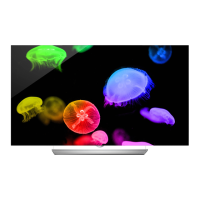
Do you have a question about the LG 65EF9500 and is the answer not in the manual?
| Screen shape | Flat |
|---|---|
| Response time | - ms |
| Display diagonal | 65 \ |
| Display brightness | - cd/m² |
| Display technology | OLED |
| Native aspect ratio | 16:9 |
| Supported video modes | 2160p |
| Screen format adjustments | 4:3, 16:9, Auto, Zoom |
| Supported graphics resolutions | 3840 x 2160 |
| Motion interpolation technology | - |
| 3D | Yes |
| 3D type | Passive |
| App store | LG Content Store |
| 3D glasses quantity | 2 |
| Supported 3D technologies | FPR 3D |
| Tuner type | Analog & digital |
| Operating system version | 2.0 |
| Operating system installed | Web OS |
| Sound modes | Clear Voice III |
| Audio decoders | DTS, Dolby Digital |
| RMS rated power | 20 W |
| Product color | Metallic, White |
| Audio formats supported | AAC, AC3, EAC3, HE-AAC, MP2, MP3, PCM, RA-Lossless, WMA |
| Image formats supported | JPEG XR, JPS, MPO |
| Video formats supported | DIVX HD |
| High Dynamic Range (HDR) supported | No |
| HDMI ports quantity | 3 |
| DVI-D ports quantity | 0 |
| USB 2.0 ports quantity | USB 2.0 ports have a data transmission speed of 480 Mbps, and are backwards compatible with USB 1.1 ports. You can connect all kinds of peripheral devices to them. |
| Ethernet LAN (RJ-45) ports | 1 |
| Consumer Electronics Control (CEC) | SimpLink |
| AC input voltage | 100 - 240 V |
| AC input frequency | 50 - 60 Hz |
| Power consumption (standby) | 0.3 W |
| Sustainability certificates | ENERGY STAR |
| Depth (with stand) | 236.2 mm |
|---|---|
| Height (with stand) | 883.9 mm |
| Weight (with stand) | 25809 g |
| Depth (without stand) | 50.8 mm |
| Width (without stand) | 1447.8 mm |
| Height (without stand) | 840.7 mm |
| Weight (without stand) | 21182 g |
Essential safety guidelines for servicing the TV.
Precautions to be taken during servicing operations.
Technical specifications of the OLED TV model.
Step-by-step instructions for adjusting TV settings.
Procedure for checking AC leakage current under operating conditions.
General guidelines for safe and effective servicing.
Handling precautions for static-sensitive electronic components.
Lists the specific adjustments to be performed.
Procedures for automated adjustment processes.
Steps for performing a LAN port ping test.
Instructions for downloading EDID/DDC data.
EDID data for HDMI2 with UHD deep color ON.
EDID data for HDMI2 with UHD deep color OFF.
EDID data for HDMI3, not supporting UHD Deep Color.
EDID data for AC3 HDMI1, 6G UHD Deep Color ON.
EDID data for AC3 HDMI2, 6G UHD Deep Color ON.
EDID data for AC3 HDMI3, 6G UHD Deep Color ON (TBD).
EDID data for AC3 HDMI2, 3G UHD Deep Color OFF.
EDID data for AC3 HDMI3, 3G UHD Deep Color OFF.
EDID data for PCM HDMI1, 6G UHD Deep Color ON.
EDID data for PCM HDMI1, 3G UHD Deep Color OFF.
EDID data for PCM HDMI2, 3G UHD Deep Color OFF.
EDID data for PCM HDMI3, 3G UHD Deep Color OFF.
Step-by-step guide for manually adjusting white balance.
Explains the objective and working principle of white balance adjustment.
Procedure for automatic white balance calibration.
Table detailing white balance settings for OLED panels.
Procedure for inspecting HDMI ARC function.
Method for checking Ground and Internal Pressure.
Procedure for checking audio output performance.
Instructions for downloading software via USB.
Circuit block diagram for LM14A and URSA9.
I2C communication block diagram for LM14A and URSA11.
Block diagram illustrating the URSA11 component.
Power distribution block diagram for LM14A and URSA11.
Block diagram showing the Tuner and CI interface.
Block diagram for video and audio input signals.
Block diagram illustrating audio output circuitry.
Block diagram for HDMI connections and signaling.
Block diagram for USB, Wi-Fi, M-Remote, and UART interfaces.
Internal block diagram of the LM14A and URSA11 processors.
Diagram showing the TV's components and their assembly.
Pin details and functions for the LGE5332 (LM14A) IC.
Core voltage regulation for the LM14A CPU.
Output wafer signals for Vx1 interface.
Serial communication interface connector.
Memory Interface Unit (MIU) for U11.
Memory Interface Unit (MIU) for U11.
Troubleshooting for "Vertical/Horizontal bar" errors.
Troubleshooting for power issues during operation.
Troubleshooting for audio distortion or noise.
Troubleshooting for circuit or mechanical noise.
Troubleshooting for physical exterior damage.
Checking Wi-Fi cable and 3.3V supply.
Checking and adjusting White Balance values.
TUNER checking part identification.
Checking LCD TV connection for input signals.
Checking link cable contact for color errors.
Checking power input voltage and ST-BY voltage.
Checking the power off mode settings.
Checking speaker and voltage for no audio issues.
